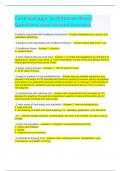2 bacteria associated with foodborne intoxication - Answer-staphylococcus aureus and
clostridium botulinum.
/.2 bacteria most associated with foodborne infection - Answer-salmonella and E. coli
/.2 foodborne illness - Answer-1. infection
2. contamination
/.2 main reasons why we cook food - Answer-1. to make food appetizing by changing its
appearance, texture, and aroma. 2. more importantly, to heat foods and destroy harmful
microorganisms that may cause illness
/.2 stage cooling process - Answer-1. 135-70 within 2 hours
2. 70-41 within 6 hours
/.2 ways to sanitize in food establishments - Answer-placing cleaned equipment and
utensils in hot water for 30 seconds and chemical sanitizing involves placing equipment
and utensil in an approved chemical sanitizing solution for a minimum of 60 seconds at
cool temperatures. sanitizers are best used in temperatures above 75 but not above
120 degrees.
/.3 compartment dish washing sink - Answer-first compartment use hot water at 110
degrees for washing, the second compartment used for rinsing and the third sink for
sanitizing with chemical with warm water
/.3 main areas of food safety and sanitation - Answer-1. time and temperature
2. heat and cold
3. the washing of hands and ware-washing (i.e., dishware, glassware, pots and pans
/.3SI - Answer-smaller portions, shallow pans, stir food, and ice bath, ice want, and ice
directly.
/.4 high risk population - Answer-1. pregnant/ nursing(lactating) women
2. infants and children
3. elderly
4. impaired immune systems
/.4 methods to thawing food - Answer-crow. cooking process, refrigeration, oven
(microwave), and water (running).
, /.7 major principles involved in operating a HACCP. - Answer-Analyze, identify,
establish, monitor, take correction action,
/.all packaging material (such as bags of flour) should be how many inches from the
ground? - Answer-At least 6 inches
/.allergies - Answer-on January 1, 2006 the federal drug administration required food
labels to state if any ingredients contained protein from the eight major allergenic foods.
this was a result of the food allergen labeling and consumer act of 2004 or FALCPA. the
8 major allergenic foods are: milk, eggs, fish shellfish, nuts derived from a tree,
soybeans, wheat, and peanuts. one major symptom is anaphylactic shock, which can
includ hives, the tightness of throat, itching, swelling, and even death
/.anisakis - Answer-parasite found in fish and seafood that produces anisakiasis.
symptoms are a tickling or tingling sensation in the throat causing the person to cough
up the actual parasite. cook fish to 145 degrees.
/.approved chemical sanitizers - Answer-1. chlorine 50 ppm. 2. iodine 12.5 3. quaternary
ammonium 200 ppm
/.Bacillus cereus - Answer-found in soil where vegetables and grains are grown. it forms
spores and can be found on cooked rice that has been improperly cooled or held at
improper temperatures. common symptoms are: nausea, vomiting, and diarrhea. The
illness can last anywhere from half a day to 24 hours.
/.back siphonage - Answer-occurs when pressure in the potable water supply drops
below that of a non potable, used, or contaminated water source. An air gap is the best
way to prevent back siphonage. the air gap bust be at least twice the diameter of the
water supply
/.bacteria doubles every how many minutes - Answer-20
/.bacterial foodborne illnesses account for more than how many percentage of all
foodborne related illness - Answer-90%
/.biological - Answer-anything that pertains to life and or living things
/.chemical contamination - Answer-can occur if an employee prepares acidic food using
a copper pot
/.chemical contamination - Answer-is caused when substances such as cleaning
compounds, acids, detergents, soaps, chemicals, and pesticides get into food. it can
occur in nature
/.ciguatera - Answer-is a type of seafood poisoning. the cause is not the fish, but what
the fish eats.




